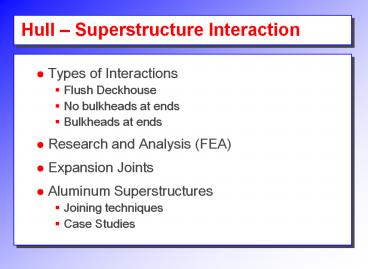Hull PowerPoint PPT Presentation
1 / 16
Title: Hull
1
Hull Superstructure Interaction
- Types of Interactions
- Flush Deckhouse
- No bulkheads at ends
- Bulkheads at ends
- Research and Analysis (FEA)
- Expansion Joints
- Aluminum Superstructures
- Joining techniques
- Case Studies
2
Types of Interaction (House flush with side)
- The superstructure bends with the hull as one
hull-girder - May consider contribution to longitudinal
strength through Moment of Inertia
3
Types of Interaction (House not flush/no
intermediate bulkheads)
Stress Risers!
- Deck beams are flexible deckhouse acts
independent of hull - Hogging and sagging puts large stresses on
connection points - Best to terminate deckhouse with WT bulkhead
(and/or longitudinal bulkhead or significant deck
girders)
4
Modes of Interaction (House not flush,
intermediate bulkheads)
Full bulkhead maintains shape
- Intermediate bulkhead forces superstructure to
undergo same deflection as the hull - Between bulkheads the strain diminishes
- Can cause large lift off forces at bottom of
deckhouse (particularly the ends) must be
considered in design (fatigue analysis)
5
Design of Deckhouses
- ABS Rules require that deckhouses with lengths
greater than 10 of ships length located at
midships have longitudinal members large enough
to give a hull-girder section modulus in the
deckhouse equal to that of the hull girder. - Usually design hull girder alone to withstand
bending moments without the deckhouse - Method is sound but conservative
6
Research and Analysis
- Non-linear stress distributions in deckhouse
Bleich - Shear and shear lag effects at deckhouse/hull
Schade - Full scale tests on SS President Wilson Vasta
- FEA (only area currently active)
7
Expansion Joints
- Joints are cut in the superstructure above the
main deck (strength deck). Bolted joints with
slots sometimes used, or simply slit with
waterproof cover. - Relieves deckhouse longitudinal bending stress so
that it acts independent of hull. - Allows deckhouse to be designed for vertical
loads and racking stresses. - Saves significant weight topside
8
Expansion Joints
9
Use of Expansion Joints
- Must be spaced close enough to relieve deckhouse
bending stresses - They introduce severe concentrations of stress at
the bottom of the joints - Can lead to creaking and leaking in seaway if
joining details not properly designed.
10
Aluminum in Deckhouses
- Advantages
- As strong as steel but Elastic Modulus 1/3 that
of steel ? stresses are 1/3 of that in steel ?
may eliminate need for expansion joints - Almost 2/3 reduction in weight over mild steel ?
lowers weight of structure and KG ? improves
stability - Disadvantages
- Coefficient of thermal expansion almost double
that of steel ? may cause distortions with
temperature variations in service - Aluminum loses strength at elevated temperatures
? detrimental to damage control - Can lead to galvanic corrosion with steel
- Difficult to join to steel structures (explosive
or biweldable joints) - More expensive than mild steel
- Potential brittleness of high strength aluminum
11
Aluminum Steel Joining Techniques
- Rivets/Bolts
- Explosion Bonding
- Process uses an explosive detonation as the
energy source to produce a metallurgical bond
between metal components. One of the metals is
accelerated by explosive detonation at a very
high rate over a short distance resulting in a
progressive collision of the materials. - The metals are forced together under several
million psi pressure creating an electron-sharing
bond that is typically stronger that the weaker
of the parent metals. - Due to its use of explosive energy, the process
occurs extremely fast unlike conventional
welding processes, parameters cannot be
fine-tuned during the bonding operation. - The bonded product quality is assured through
selection of proper process parameters material
surface preparation, plate separation distance
prior to bonding, and explosive load, velocity,
and detonation energy. - Biweldable strips (2002)
Source Clad Metal Division - Dynamic Materials
Corp.
12
Aluminum in Naval Warships
- U.S. Warships
- Prior to DDG-51 most warships used aluminum in
their superstructures for its various advantages - 1975 USS Belknap collided with USS John F.
Kennedy and a major fire broke out on Belknap
that melted most of its superstructure - 1991 USS Princeton detonated an Italian-made MRP
acoustic mine under the ships quarterdeck. The
blast detonated another mine three-hundred yards
off the starboard beam. - A six-inch crack opened in the Princetons
aluminum superstructure running up one side and
down the other. More than 10 of the
superstructure separated from the main deck.
13
USS Belknap - 1975
14
NAVSEA Inspection Procedure
15
Inspection Guidelines
16
USS Radford (DD 968) collision (1999)
Split at bi-metallic joint in deck house frame 174

